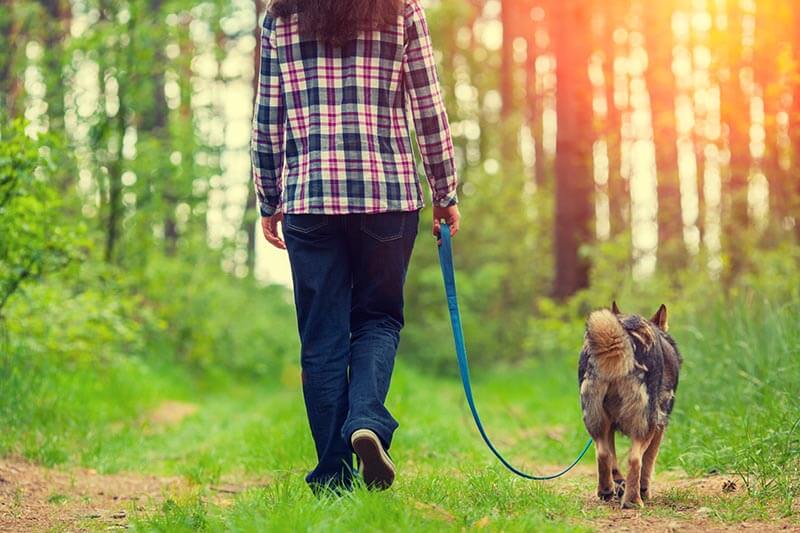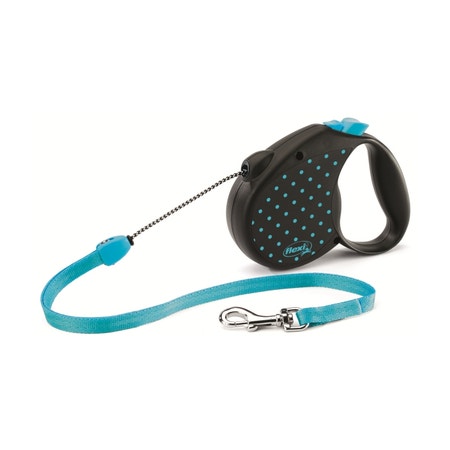Learning to walk on the lead correctly is an important skill for your dog or puppy to learn if you both want to have fun going on walks together. Here’s our guide on how to stop your dog pulling on the lead.
When you step out the front door, you and your dog should enjoy walking together with a loose lead. Pulling on the lead is a common and frustrating habit, but one that’s important to get on top of. Before we get in to techniques you can use to make on-lead walks stress-free for both of you, understand why your puppy or dog may be pulling on the lead so you can start your training on the right paw.
Why is my dog pulling on the lead?
You may think that your dog is being disobedient when they pull on the lead, but there is a reason that many puppies and dogs do this. Compared to them, humans walk at a much slower speed. We like to leisurely stroll while dogs will naturally trot, so your dog pulling on the lead can be their way of telling you to hurry up. In addition, we like to move with purpose taking the most direct route from A to B while your puppy or dog will likely want to meander about and investigate the new sights and smells around them. Due to these differences, it takes time and patience to teach a dog to walk at your pace.
How can I stop my dog from pulling on their lead?
Gauge energy levels
Before you start walking your dog, it’s important to first gauge your pet’s energy levels. If your puppy or dog is at heightened level of excitement and full of energy, then you can predict that they’ll be pulling on the lead throughout your walk. To avoid frustration, tire them out with a few games of tug-of-war or backyard fetch before you head out. This should use up a bit of that energy and put them in a more relaxed frame of mind to start your lesson on the lead.
Recommended Rope and Fetch Toys
Use the right equipment
When your dog pulls on the lead, the number one thing not to do is yank back in retaliation. This is sudden and frightening for your pet and can even injure their neck. To ease the pressure on their neck and to discourage your dog from pulling on their lead, use a harness that goes around their chest instead of a collar.
Recommended Dog Harnesses
In this type of harness, the leash is attached to a ring on the chest strap so when your dog pulls on their lead, it will turn their body around instead of letting them move forward like they want to. After a few unsuccessful attempts to drag you along, your puppy or dog will realise that pulling on the lead doesn’t get them anywhere and they’ll learn to stop.
Reduce the pace
Try encouraging your dog to slow down with a reward. Every time your puppy or dog walks at a reasonable pace, or ignores an alluring scent, praise them and give them a reward – whether a pat or a nutritious treat. Rewarding them frequently will reduce the pace of the walk and teach them to pay more attention to you.
Stop, start, stop again
If your dog is straining against you, simply come to a stop and wait until there’s no tension on the lead, then start walking once more. If your dog pulls at the lead again, repeat the process. You can also use treats to lure your puppy or dog back to your side. This method teaches your dog that straining on the lead means that their walk will not continue. Remember to never give in to your dog when they pull on the lead because you want to send them the same message every time.
Recommended Leads
Short and sweet
Especially if you’re training a young puppy to walk on a lead, shorter sessions are better. Keep your lessons to about 10 minutes so you can both remain attentive throughout. Always keep training sessions positive and don’t forget the rewards. Puppy school is a great way to learn how to lead train your puppy and teach them basic cues in a fun and safe environment. Petbarn runs our puppy school program alongside Greencross Vets in selected stores near you so enrol your pet now!
Walking together will be a big part of your lives, so master these steps and stop your dog pulling on the lead early to ensure you have a strong partnership.













